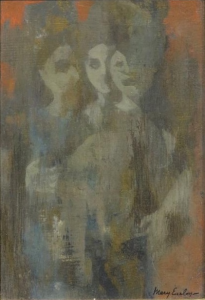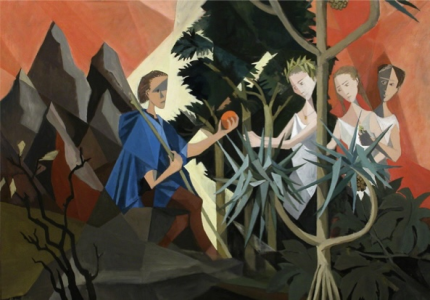Biography
Mary Ellen Sexton was born in St. Louis. Her family moved to Chicago, where she spent her childhood, except for summers when she would visit her grandmother in a town along the Missouri River. She recalled loving to look at pictures in the Art Institute, her first introduction to art. After two years of college she attended classes at the Art Students League in New York. Her teachers were Kenneth Hays Miller, who instructed a long line of well-known artists; Kimon Nicolaïdes, an influential drawing teacher; and William Palmer, who completed a number of Depression Era murals.
Following her time at the Art Students League, Mary traveled to Europe, viewing frescoes in Italy and mosaics in Pompeii. She subsequently visited Mexico, where she saw the Mayan ruins and became acquainted with the works of Orozco and Rivera. She also made several trips to Cuba.
In 1925 Mary married Ernest Howell Earley, a Dartmouth College graduate who became a spectacularly successful agent for Northwestern Mutual Life Insurance. They settled in New York City.
In 1934 the couple built a house in Woodstock, NY. Mary put on a one-woman show with the Sawkill Group in 1937. Her paintings were included in a nationwide traveling exhibition. And a major coup for her was a winning entry in the 48 States Competition of 1939. Her mural on the "Down-Rent War" was hung in the Delhi, NY Post Office; it was exhibited at the Corcoran Gallery of Art in Washington; and it was included in a photo spread in Life Magazine (December 4, 1939).
In 1940 Mary Earley joined the Executive Committee of the Woodstock Artists Association. She exhibited as part of the Carnegie Institute's "Directions of American Painting" in 1941. And the same year she received a commission for "Dance of the Hop Pickers" in the Middleburgh, NY Post Office. She continued painting in Woodstock, dying there in 1992.


Critical Analysis
Both of Mary Earley's Post Office murals reflect a deep knowledge of New York State history. The Delhi mural commemorates a seemingly-obscure event at Andes, New York, when a group of farmers defied a pair of sheriffs who had come to seize some animals for non-payment of rent. This whole scene was a remnant of the feudal structure of New York agrarian society. And the murder of one of the sheriffs produced an overreaction from the state government that ultimately led to a complete overhaul of this obsolete and oppressive regime.
The Middleburgh mural refers to a less dramatic event, to say the least. It's just a celebration of life among the hop pickers of Central New York. What may be forgotten today is that this region was once a center of hops growing for the nation. Indeed, farmers are now reviving some of the heritage hops varieties as part of the modern craft beer movement. So, although Earley's mural was painted during Prohibition, in a way she saw forward to a possible resurgence of this local industry.
More interesting, perhaps, is the style of Earley's work. The Hop Pickers murals is certainly light and entertaining. But the Down-Rent War mural, while somewhat stylized in composition, has a note of other-wordliness and dread. The farmers were disguised in animal costumes that their wives had sewn from calico and were referred to as "Calico Indians." And their poses are certainly menacing, as befits the act of murder that was about to be committed.
Earley's easel paintings sometimes carry a similar sort of foreboding. John P. O'Grady attributes this to Mary Earley's childhood experiences, where a certain painting at her grandmother's house inspired a measure of dread every time she saw it. This is not, however, true of all her paintings. The "Judgment of Paris," for example, departs from the hazy foreboding of "Undeliverable" and offers clear, bright, somewhat cubist images.
Murals
- Delhi, New York - Post Office: Down-Rent War
- Middleburgh, New York - Post Office: Dance of the Hop Pickers
References
- In Memoriam - 1918 - Ernest Howell Earley (Dartmouth Alumni Magazine).
- Thomas Pullyblank, The Long Way Home: Writing "Ariel's Gift", Thousand Islands Life Volume 15, Issue 8, August (2020).
- Mary Earley (Wikipedia).
- Mary Earley (askART).
- John P. O'Grady, Mary Earley’s Dark Angels, John P. O'Grady May 24 (2022).
- Overlooked: Woodstock Women Artists (Woodstock School of Art).